It is
a matter of common knowledge that the vocabulary of any language is
never stable, never static, but is constantly changing, growing and
decaying. The changes in the vocabulary of a language are due both to
linguistic and extralinguistic causes or to a combination of both.
The extralinguistic causes are determined by the social
8
nature of the language. In
this respect there is a tremendous difference between Lexicology, on
the one hand, and Phonology, Morphology and Syntax, on the other.
Words, to a far greater degree than sounds, grammatical forms, or
syntactical arrangements, are subject to change, for the word-stock
of a language directly and immediately reacts to changes in social
life, to whatever happens in the life of the speech community in
question. To illustrate the immediate connection between the
development of vocabulary and the extra-linguistic causes a few
examples will suffice.
The
intense development of science and technology has lately given birth
to a great number of new words such as computer,
cyclotron, radar, psycholinguistics, etc.;
the conquest and research of outer space started by the Soviet people
contributed words like sputnik,
lunokhod, babymoon, moon-car, spaceship, etc.
It is significant that the suffix -nik
occurring
in the noun sputnik
is
freely applied to new words of various kinds, e.g. flopnik,
mousenik, woofnik, etc.1
The
factor of the social need also manifests itself in the mechanism of
word-formation. Among the adjectives with the suffix -y
derived from noun stems denoting fabrics (cf. silky,
velvety, woolly, etc.)
the adjective tweedy
stands
out as meaning not merely resembling or like tweed but rather ‘of
sports style’. It is used to describe the type of appearance (or
style of clothes) which is characteristic of a definite social group,
namely people going in for country sports. Thus, the adjective tweedy
in
this meaning defines a notion which is specific for the speech
community in question and is, therefore, sociolinguistically
conditioned.
From
the above-adduced examples it follows that in contrast with
Phonology, Morphology and Syntax, Lexicology is essentially a
sociolinguistic science. The lexicologist should always take into
account correlations between purely linguistic facts and the
underlying social facts which brought them into existence, his
research should be based on establishing scientifically grounded
interrelation and points of contact which have come into existence
between the language and the social life of the speech community in
question.
§ 4. Lexical Units
It was pointed out above that Lexicology
studies various lexical units: morphemes, words, variable word-groups
and phraseological units. We proceed from the assumption that the
word is the basic unit of language system, the largest on the
morphologic and the smallest on the syntactic plane of linguistic
analysis. The word is a structural and semantic entity within the
language system.
It should be pointed out that
there is another approach to the concept of the basic language unit.
The criticism of this viewpoint cannot be discussed within the
framework of the present study. Suffice it to say that here we
consistently proceed from the concept of the word as the basic unit
in all the branches of Lexicology. Both words and phraseological
units are names for things, namely the names of actions, objects,
qualities, etc. Unlike words proper, however, phraseological units
are word-
l
‘Various aspects…’, §
6, p.
180
9
groups
consisting of two or more words whose combination is integrated as a
unit with a specialised meaning of the whole. To illustrate, the
lexical or to be more exact the vocabulary units tattle,
wall, taxi are
words denoting various objects of the outer world; the vocabulary
units black
frost, red tape, a skeleton in the cupboard are
phraseological units: each is a word-group with a specialised meaning
of the whole, namely black
frost is
‘frost without snow or rime’, red
tape denotes
bureaucratic methods, a
skeleton in the cupboard refers
to a fact of which a family is ashamed and which it tries to hide.
Varieties
of Words
Although the ordinary ’speaker
is acutely word-conscious and usually finds no difficulty either in
isolating words from an utterance or in identifying them in the
process of communication, the precise linguistic definition of a word
is far from easy to state; no exhaustive definition of the word has
yet been given by linguists.
The
word as well as any linguistic sign is a two-facet unit possessing
both form and content or, to be more exact, soundform and meaning.
Neither can exist without the other. For example, [θimbl]
is a word within the framework of the English language primarily
because it has the lexical meaning —
‘a
small cap of metal, plastic, etc. worn on the finger in sewing..
.’1
(Russ.
наперсток)
and
the grammatical meaning of the Common case, singular. In other
languages it is not a word, but a meaningless sound-cluster.
When used in actual speech the
word undergoes certain modification and functions in one of its
forms.
The
system showing a word in all its word-forms is called its paradigm.2
The lexical meaning оf
а
word
is the same throughout the paradigm, i.e. all the word-forms of one
and the same word are lexically identical. The grammatical meaning
varies from one form to another (cf. to
take, takes, took, taking or
singer,
singer’s, singers, singers’). Therefore,
when we speak of the word singer
or
the word take
as
used in actual utterances (cf., His brother is a well-known singer or
I
wonder who has taken my umbrella) we use the term word
conventionally, because what is manifested in the speech event is not
the word as a whole but one of its forms which is identified as
belonging to one definite paradigm.
There are two approaches to
the paradigm: (a) as a system of forms of one word it reveals the
differences and relationships between them; (b) in abstraction from
concrete words it is treated as a pattern on which every word of one
part of speech models its forms, thus serving to distin-
1Here
and elsewhere definitions of the meanings of words are borrowed from
a number of English explanatory dictionaries, such as the Concise
Oxford Dictionary, Oxford Advanced Learner’s Dictionary of Current
English by A.
S. Hornby, L., 1974
and
others.
2 Each
part of speech is characterised by a paradigm of its own. Nouns are
declined, verbs conjugated, qualitative adjectives have degrees of
comparison. Some adverbs also have degrees of comparison (e.g. well,
badly, etc.),
others are immutable (e.g. here,
there, never). Word-forms
constituting a paradigm may be both synthetic and analytic. Unlike
synthetic forms an analytic form is composed of two separate
components (cf. (he) takes …
and
(he) has taken …).
In
some cases the system of word-forms combines different roots (cf. to
go —
went
—
gone;
good —
better
—
best).
10
guish
one part of speech from another. Cf. the noun paradigm —
( ), -’s,
-s,
-s’ as
distinct from that of the regular verb —
( ) ,-s,
-ed1,
-ed2,
-ing,
etc.1
Besides
the grammatical forms of words, i.e. word-forms, some scholars
distinguish lexical varieties which they term variants
of words.
Distinction
is made between two basic groups of variants of words.
In
actual speech a word or to be more exact a polysemantic word is used
in, one of its meanings. Such a word in one of its
meanings is described as lexico-semantic variant. Thus Group One
comprises lexico-semantic variants, i.e. polysemantic words in each
of their meanings, as exemplified by the meaning of the verb to
learn in
word-groups like to
learn at school, cf.
to
learn about (of) smth, etc.
Group
Two comprises phonetic and morphological variants. As examples of
phonetic variants the pronouncing variants of the adverbs often
and
again
can
be given, cf. [‘o:fn] and [‘o:ftэn],
[э’gein]
and [э’gen].
The two variant forms of the past indefinite tense of verbs like to
learn illustrate
morphological variants, cf. learned
[-d] and
learnt
[-t]. Parallel
formations of the geologic
— geological,
phonetic
— phonetical
type
also enter the group of morphological variants.2
It may be easily observed that
the most essential feature of variants of words of both groups is
that a slight change in the morphemic or phonemic composition of a
word is not connected with any modification of its meaning and, vice
versa, a change in meaning is not followed by any structural changes,
either morphemic or phonetic. Like word-forms variants of words are
identified in the process of communication as making up one and the
same word. Thus, within the language system the word exists as a
system and unity of all its forms and variants.
- Размер: 211 Кб
- Количество слайдов: 39
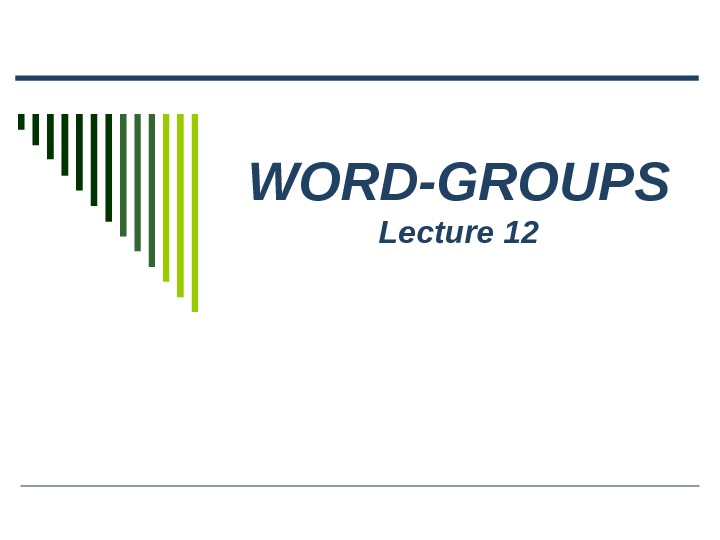
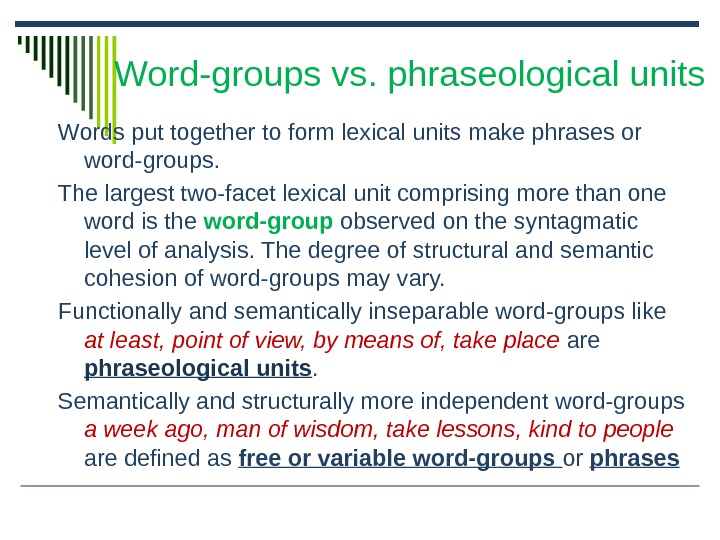
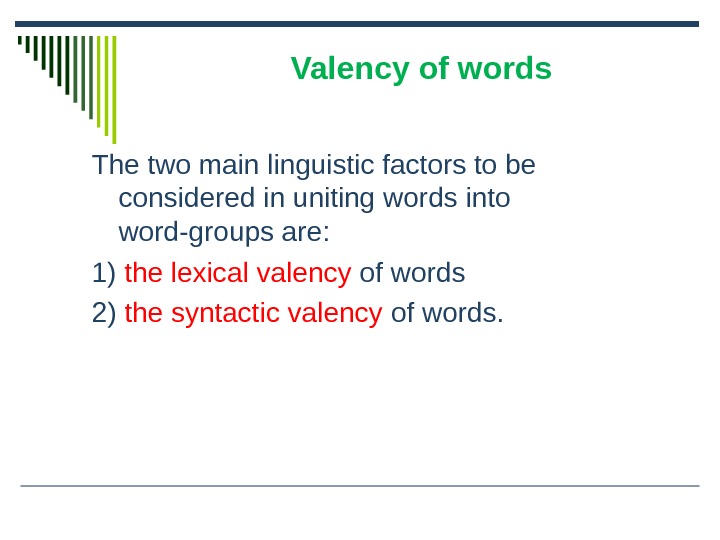
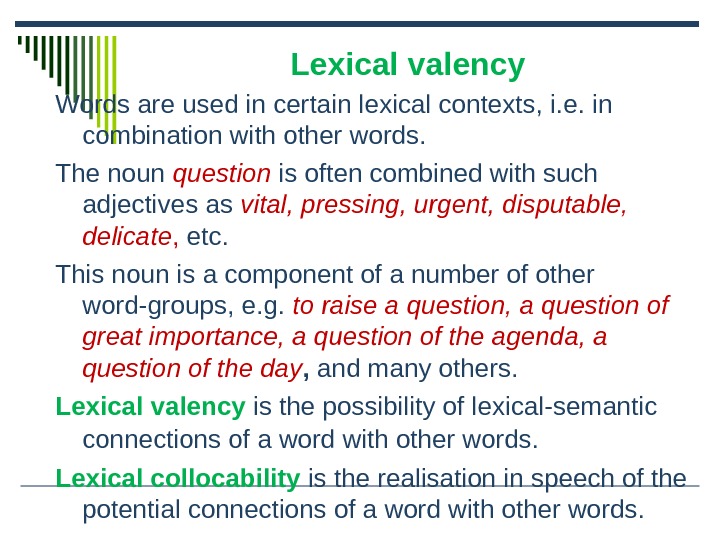
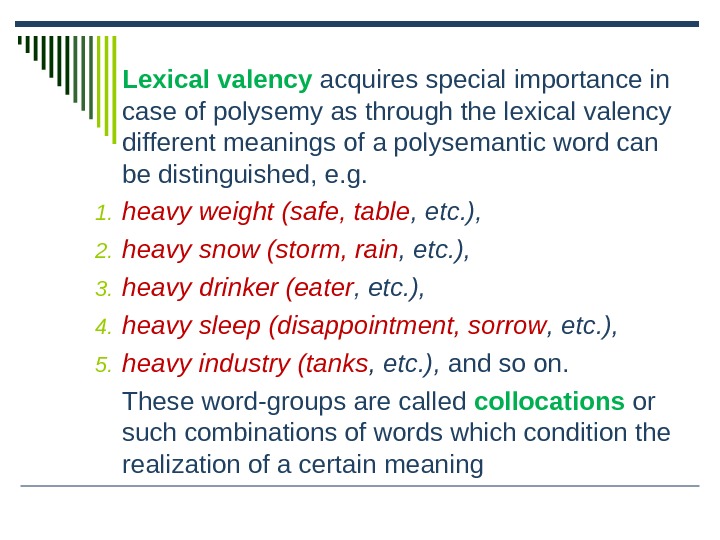
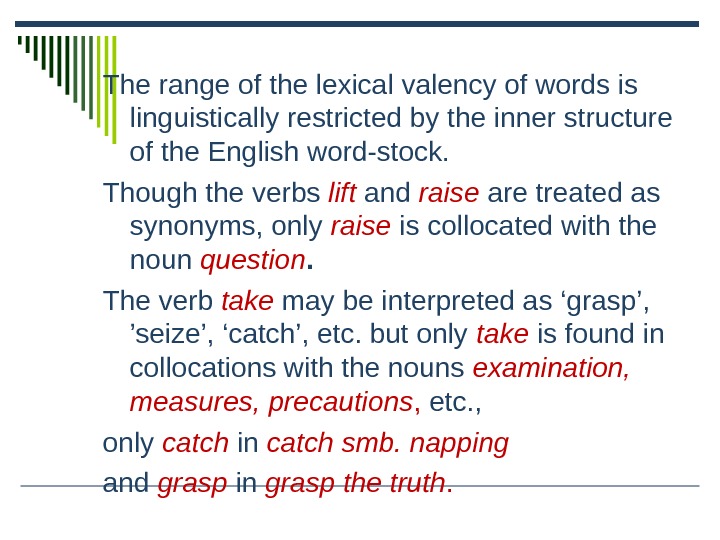
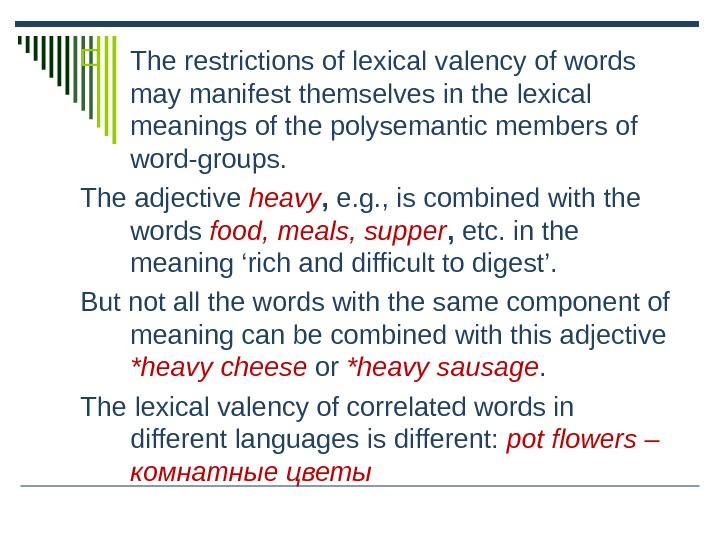
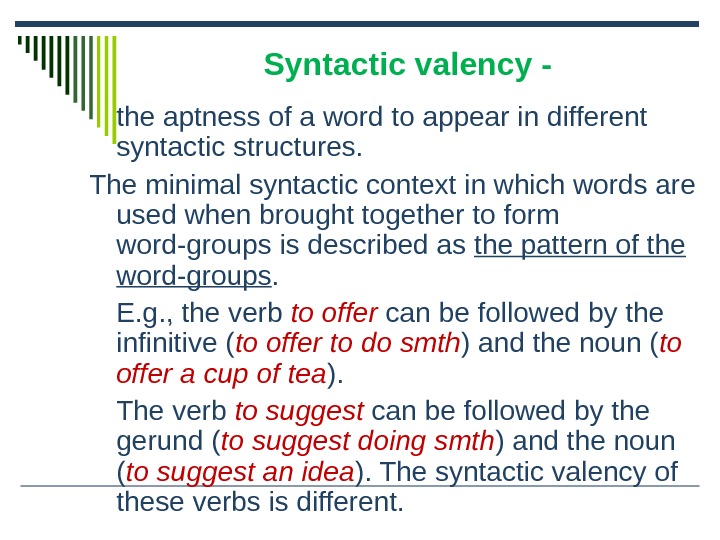
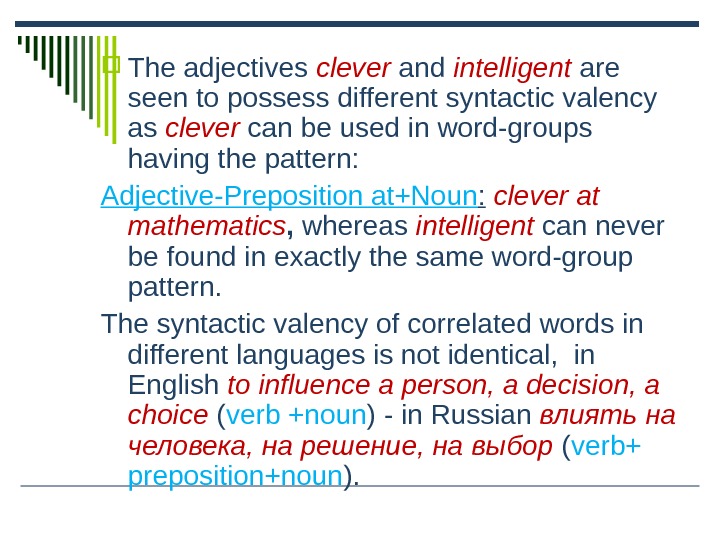
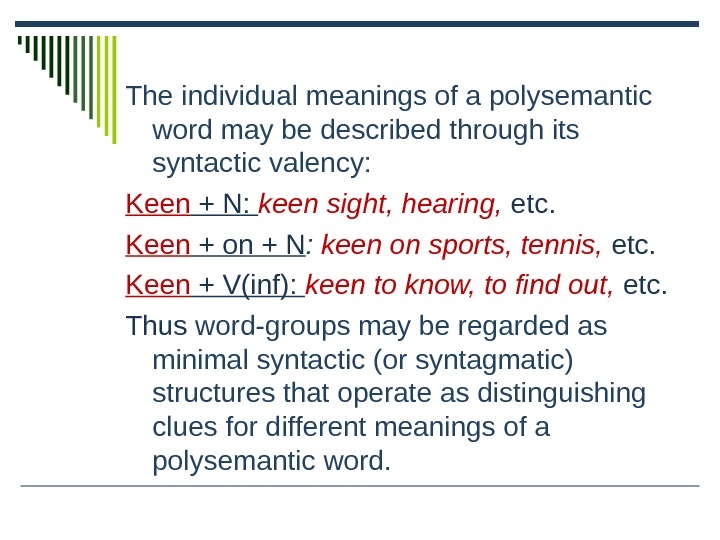
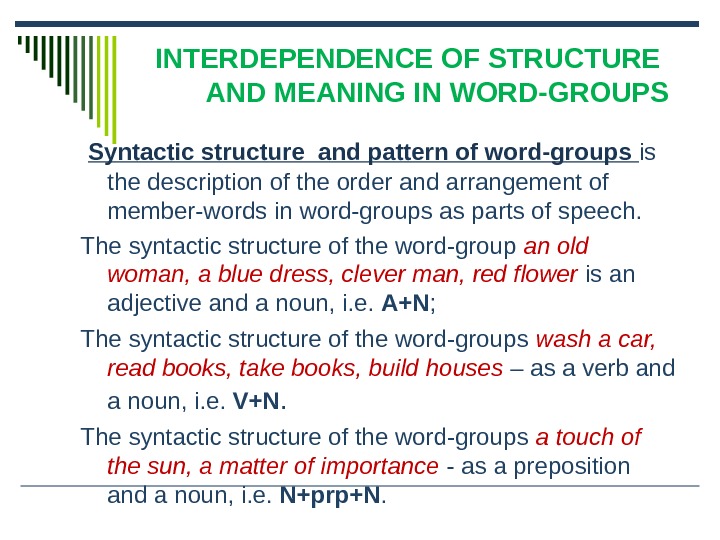
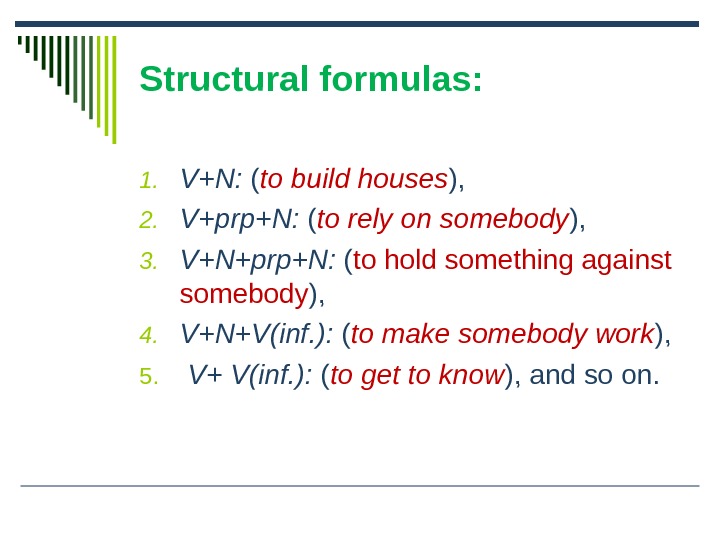
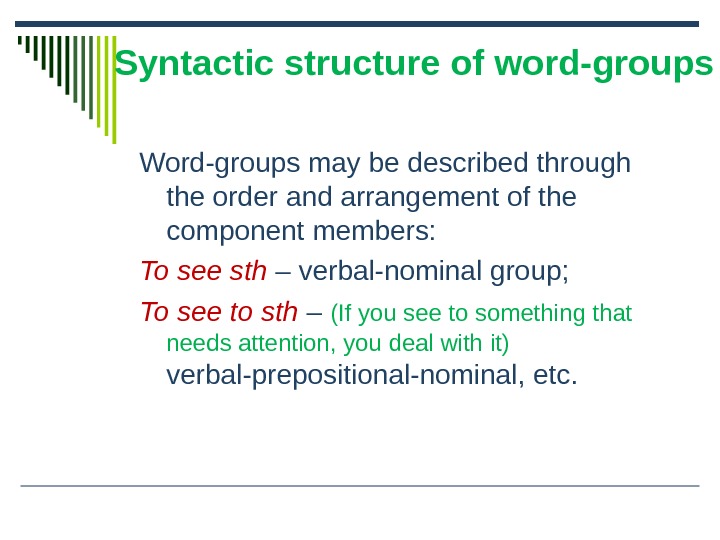
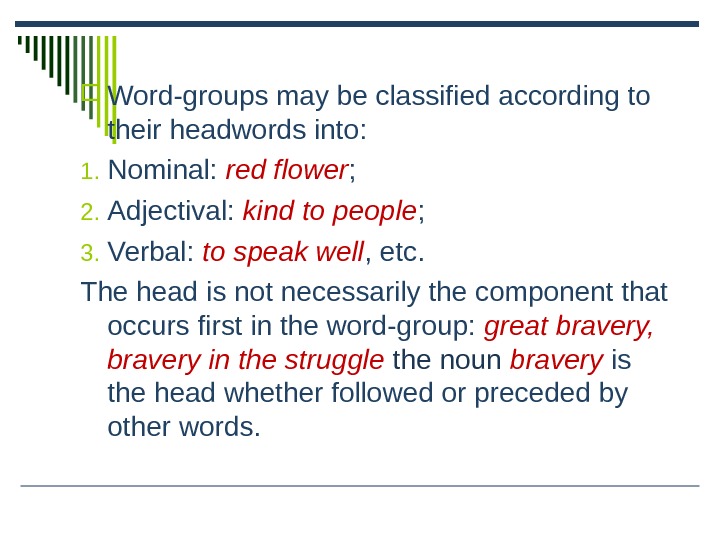
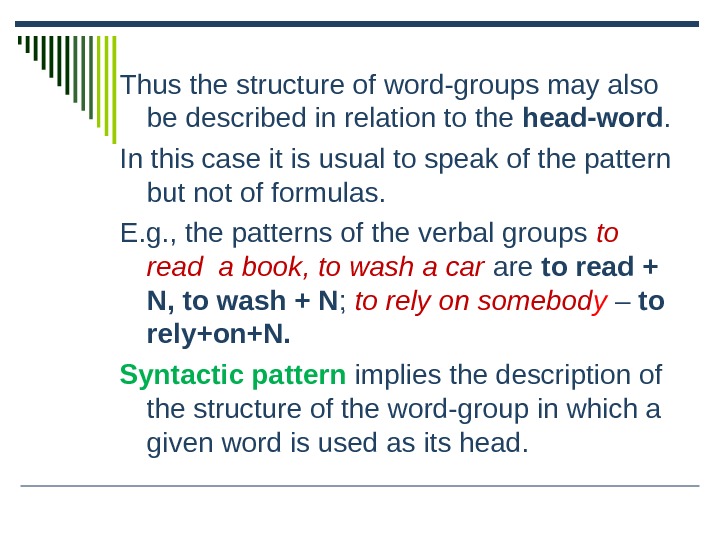

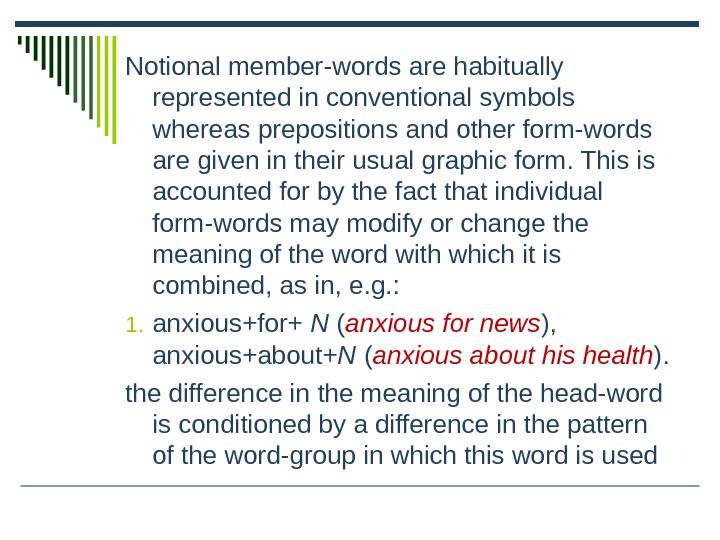
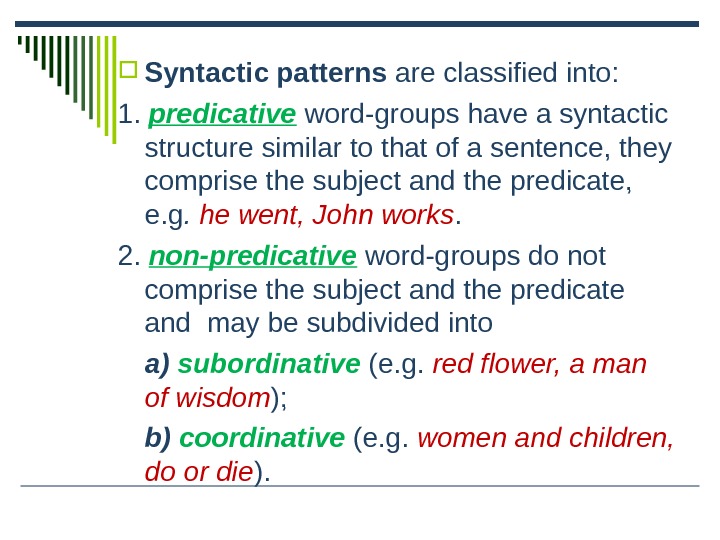
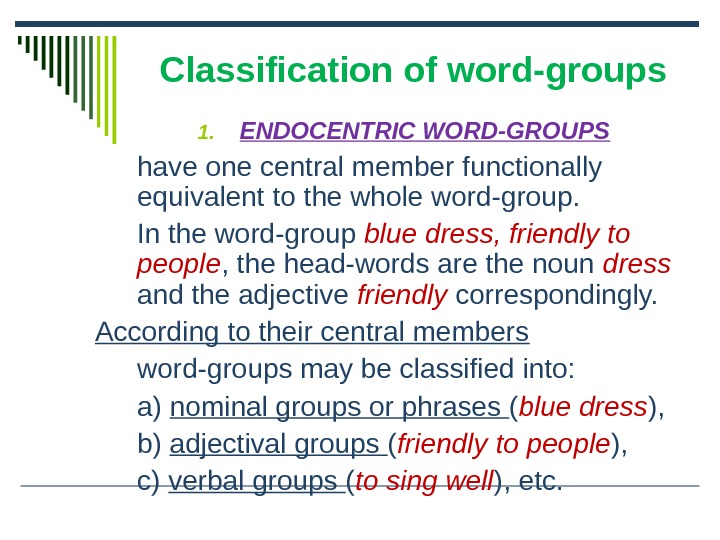
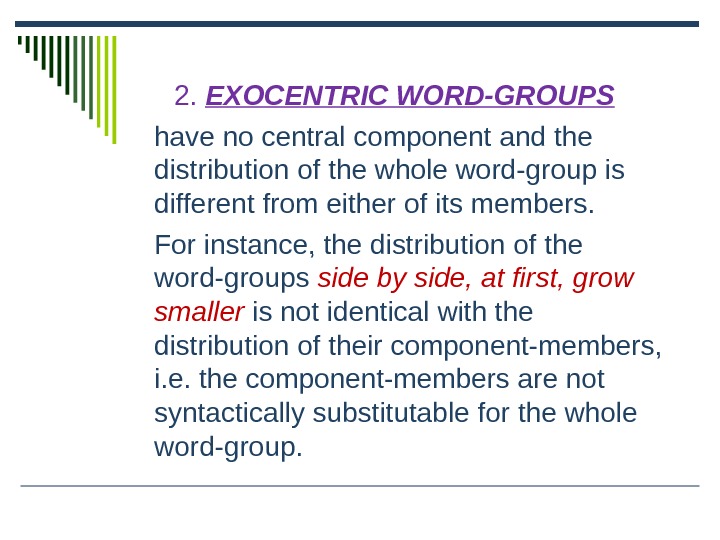
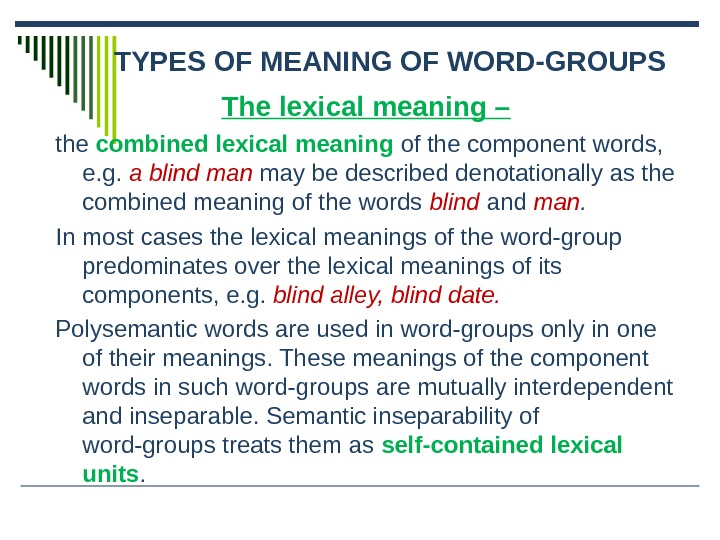
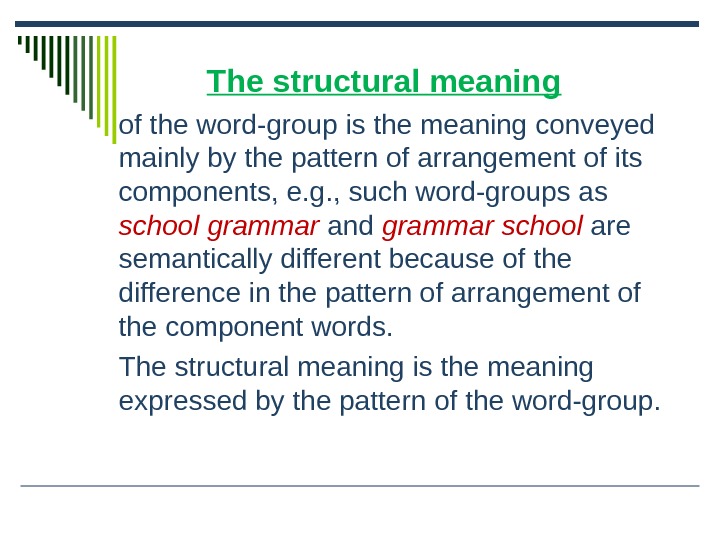
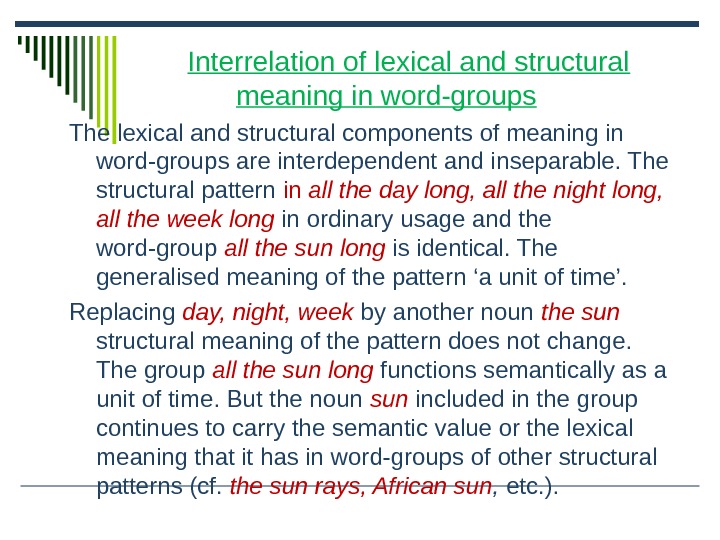
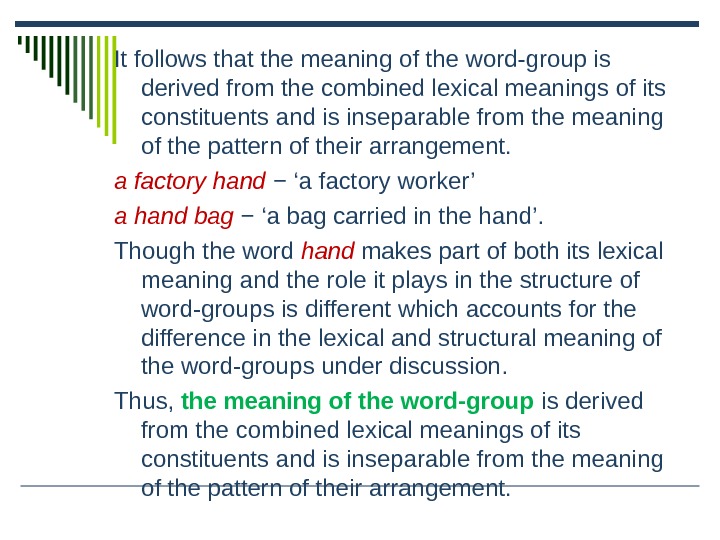
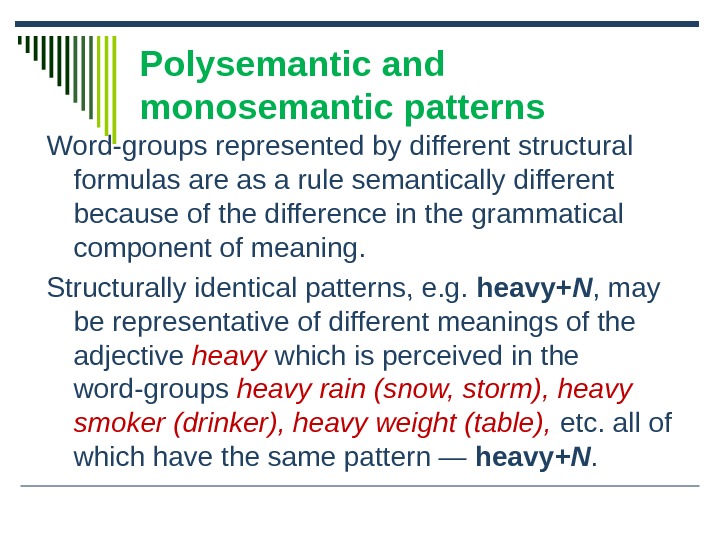
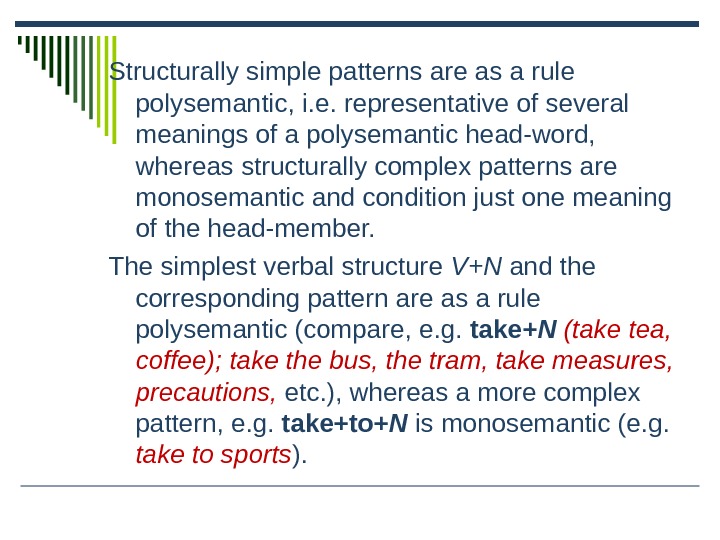
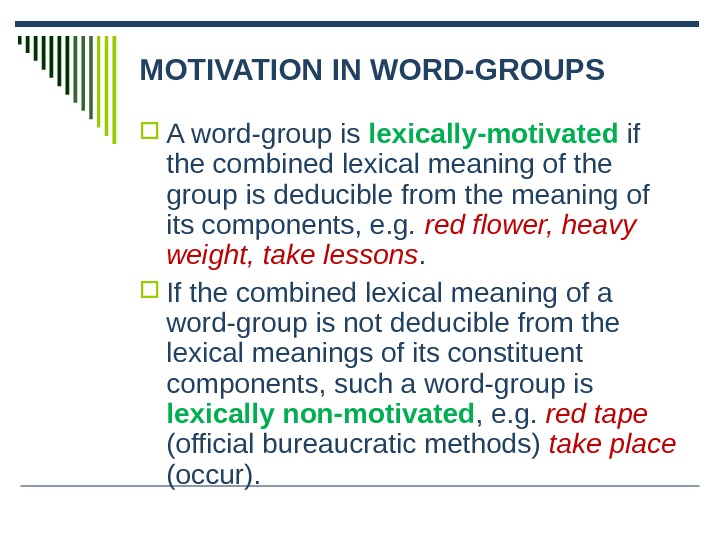
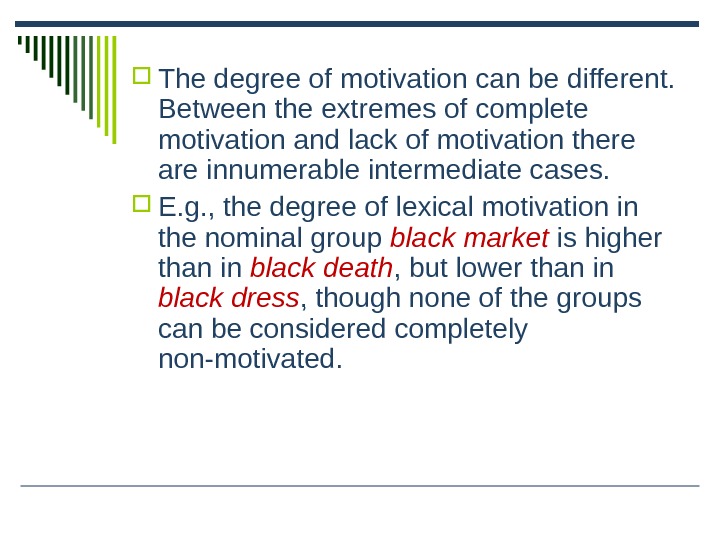
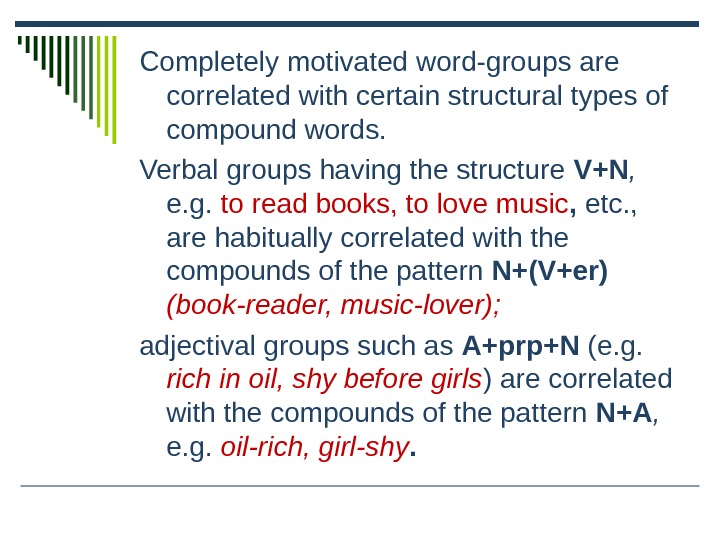
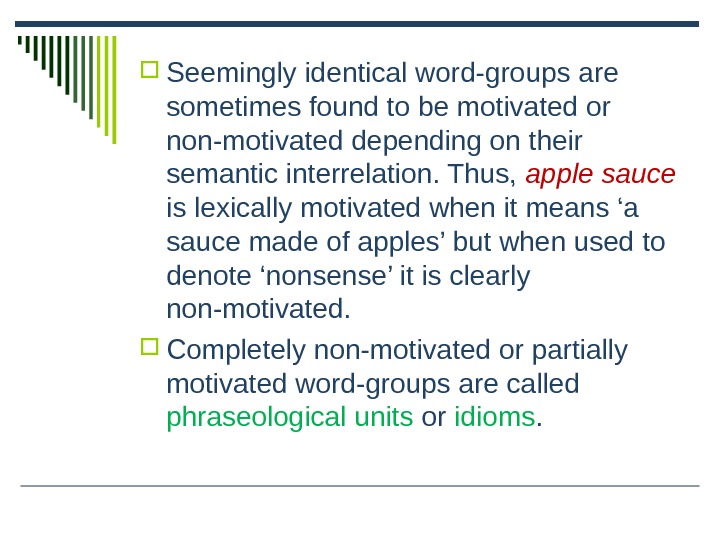
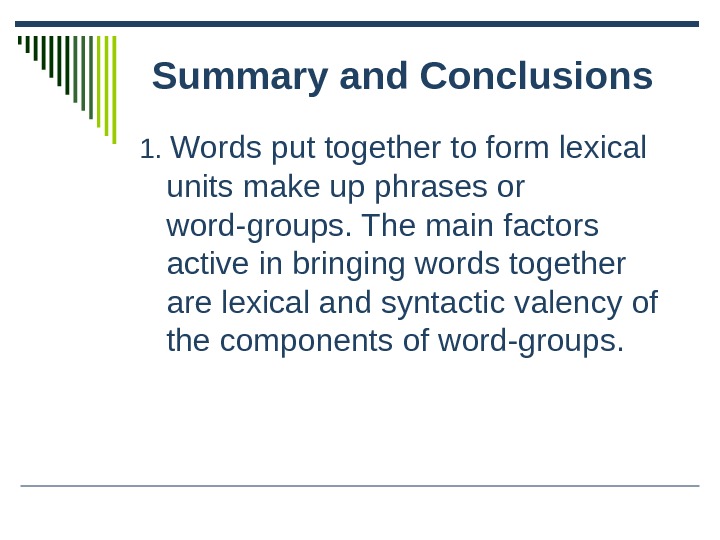
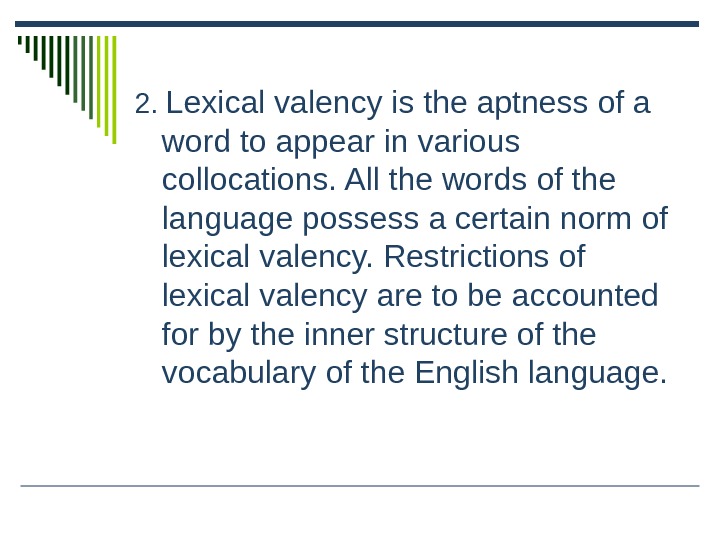
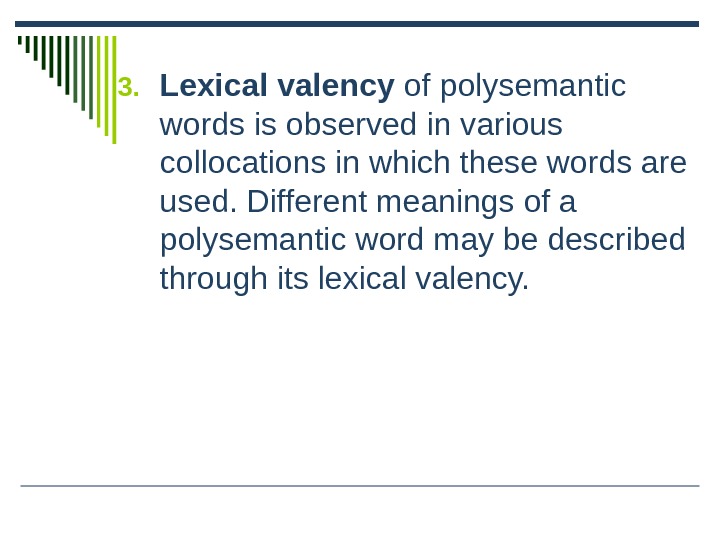
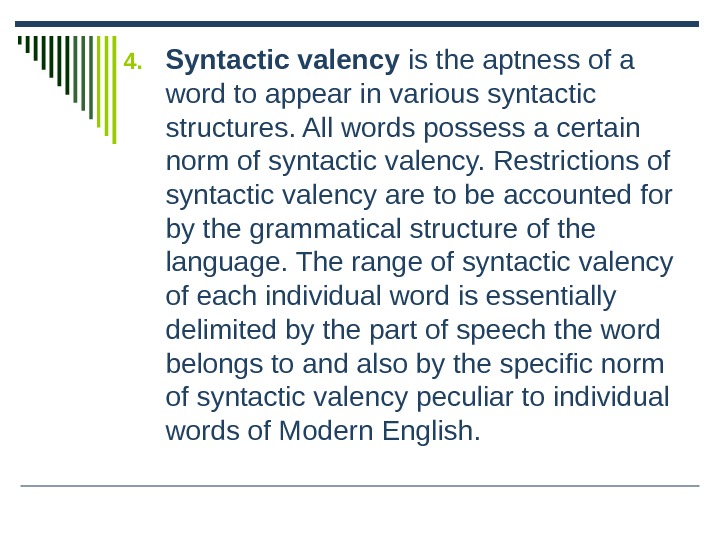
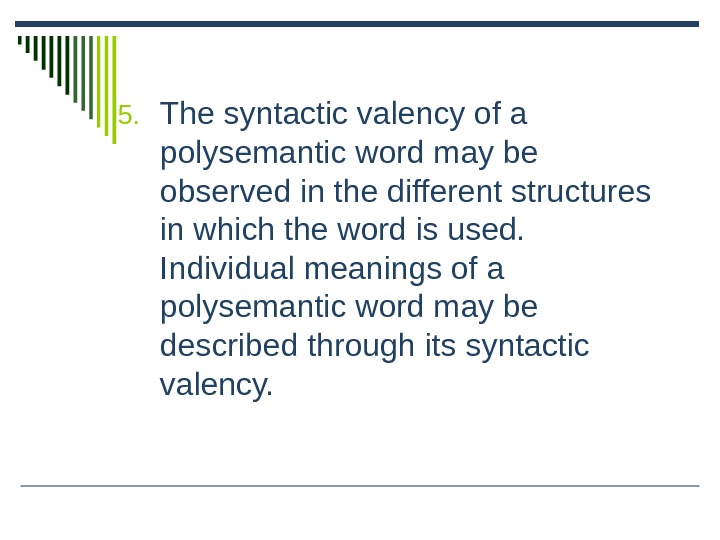
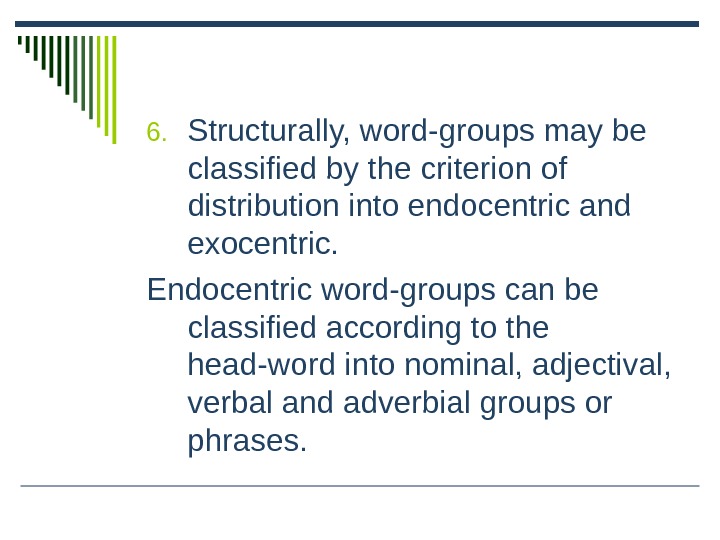
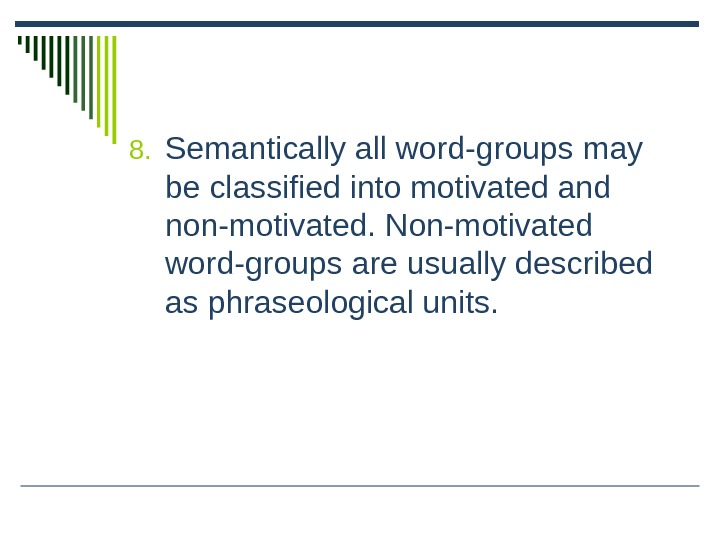
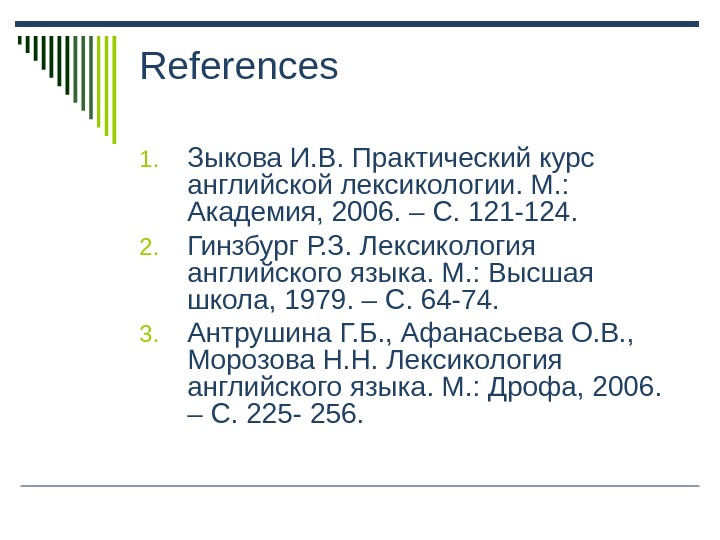

The word-group theory in Modern English
word-group
theory in Modern English
Content
Introduction
.
Definition and general characteristics of the
word-group
.
Classification of word-groups
.
Semantic features of word-groups
.
Motivated and non-motivated word-groups
.
Phraseological word-groups
Introduction
is a branch of linguistics — the
science of language. Lexicology as a branch of linguistics has its own aims and
methods of scientific research. Its basic task — being a study and systematic
description of vocabulary in respect to its origin, development and its current
use. Lexicology is concerned with words, variable word-groups, phraseological
units and morphemes which make up words.the object of the linguistic research
within the frameworks of the lexicological analysis, word-groups draw much
attention of different scientists at different stages of the research
history.linguists as Shveitser, Arnold, Nikitin, Akhmanova, Marchenko, and many
others devoted their research papers to the matter of the word-groups, their
classification, semantic features, and other specific characteristics. They
have contributed linguistic research with a number of works, connected with
this lexical units. The matter of the word-group thorough study is topical with
a glance at their specific features, some phraseological peculiarities and
semantic-grammatical structure.above-mentioned aspects have predetermined our
choice of the topic of the present report «The word-group theory in Modern
English».object of the investigation are word-groups of Modern
English.subject of the present report includes specific features and
characteristics of word-groups.purpose of the report writing is to investigate
word-groups functioning in the Modern English language.purporse of the report
has predetermined the following tasks of the investigation:
to define the notion of the
word-group and outline its general characteristics;
to suggest the classification of the
word-group;
to consider semantic features of
word-groups;
to characterize motivated and
non-motivated word-groups;
to specify peculiar features of
phraseological word-groups.practical value of the present report is performed
by the possibility of using its materials for the further thorough study of
this matter.
1. Definition and general
characteristics of the word-group
word group is the simplest
nonpredicative (as contrasted to the sentence) unit of speech. The word group
is formed on a syntactic pattern and based on a subordinating grammatical
relationship between two or more content words. This relationship may be one of
agreement, government, or subordination. The grammatically predominant word is
the main element of the word group, and the grammatically subordinated word the
dependent element.word group denotes a fragment of extralinguistic reality. The
word group combines formally syntactic and semantically syntactic features.
Such features reveal the compatibility of grammatical and lexical meanings with
the structure of the object-logical relations that these meanings
reflect.groups may be free or phraseological. Free word groups are formed in
accordance with regular and productive combinative principles; their meanings
may be deduced from those of the component words.are a lot of definitions
concerning the word-group. The most adequate one seems to be the following: the
word-group is a combination of at least two notional words which do not
constitute the sentence but are syntactically connected. According to some
other scholars (the majority of Western scholars and professors B.Ilyish and
V.Burlakova — in Russia), a combination of a notional word with a function word
(on the table) may be treated as a word-group as well. The problem is
disputable as the role of function words is to show some abstract relations and
they are devoid of nominative power. On the other hand, such combinations are
syntactically bound and they should belong somewhere.characteristics of the
word-group are:
) As a naming unit it differs from a
compound word because the number of constituents in a word-group corresponds to
the number of different denotates: a black bird — чорний птах (2), a blackbird
— дрізд (1);loud speaker (2), a loudspeaker (1).
) Each component of the word-group
can undergo grammatical changes without destroying the identity of the whole
unit: to see a house — to see houses.
) A word-group is a dependent
syntactic unit, it is not a communicative unit and has no intonation of its own
[4; p. 28].
groups can be classified on the
basis of several principles:
a)
According to the type of syntagmatic
relations: coordinate (you and me), subordinate (to see a house, a nice dress),
predicative (him coming, for him to come),
b)
According to the structure: simple
(all elements are obligatory), expanded (to read and translate the text —
expanded elements are equal in rank), extended (a word takes a dependent
element and this dependent element becomes the head for another word: a beautiful
flower — a very beautiful flower).
1) Subordinate
word-groups.word-groups are based on the relations of dependence between the
constituents. This presupposes the existence of a governingwhich is called the
head and the dependent element which is called the adjunct (in noun-phrases) or
the complement (in verb-phrases).to the nature of their heads, subordinate
word-groups fall into noun-phrases (NP) — a cup of tea, verb-phrases (VP) — to
run fast, to see a house, adjective phrases (AP) — good for you, adverbial
phrases (DP) — so quickly, pronoun phrases (IP) — something strange, nothing to
do.formation of the subordinate word-group depends on the valency of its
constituents. Valency is a potential ability of words to combine. Actual
realization of valency in speech is called combinability [6; p. 162-163].
) The noun-phrase (NP).word-groups
are widely spread in English. This may be explained by a potential ability of
the noun to go into combinations with practically all parts of speech. The NP
consists of a noun-head and an adjunct or adjuncts with relations of
modification between them. Three types of modification are distinguished here:
a)
Premodification that comprises all
the units placed before the head: two smart hard-working students. Adjuncts used
in pre-head position are called pre-posed adjuncts.
b)
Postmodification that comprises all
the units all the units placed after the head: students from Boston. Adjuncts
used in post-head position are called post-posed adjuncts.
c)
Mixed modification that comprises
all the units in both pre-head and post-head position: two smart hard-working
students from Boston.
) Noun-phrases with pre-posed
adjuncts.noun-phrases with pre-posed modifiers we generally find adjectives, pronouns,
numerals, participles, gerunds, nouns, nouns in the genitive case (see the
table) [8; p. 43]. According to their position all pre-posed adjuncts may be
divided into pre-adjectivals and adjectiavals. The position of adjectivals is
usually right before the noun-head. Pre-adjectivals occupy the position before
adjectivals. They fall into two groups: a) limiters (to this group belong
mostly particles): just, only, even, etc. and b) determiners (articles,
possessive pronouns, quantifiers — the first, the last).of nouns by nouns (N+N)
is one of the most striking features about the grammatical organization of
English. It is one of devices to make our speech both laconic and expressive at
the same time. Noun-adjunct groups result from different kinds of transformational
shifts. NPs with pre-posed adjuncts can signal a striking variety of
meanings:peace — peace all over the worldbox — a box made of silverlamp — lamp
for tableslegs — the legs of the tablesand — sand from the riverchild — a child
who goes to schoolgrammatical relations observed in NPs with pre-posed adjuncts
may convey the following meanings:
1)
subject-predicate relations: weather
change;
2)
object relations: health service,
women hater;
3)
adverbial relations: a) of time:
morning star,
b) place: world peace, country
house,) comparison: button eyes,) purpose: tooth brush.is important to remember
that the noun-adjunct is usually marked by a stronger stress than the
head.special interest is a kind of ‘grammatical idiom’ where the modifier is
reinterpreted into the head: a devil of a man, an angel of a girl.
) Noun-phrases with post-posed
adjuncts.with post-posed may be classified according to the way of connection
into prepositionless and prepositional. The basic prepositionless NPs with post-posed
adjuncts are: Nadj. — tea strong, NVen — the shape unknown, NVing — the girl
smiling, ND — the man downstairs, NVinf — a book to read, NNum — room
ten.pattern of basic prepositional NPs is N1 prep. N2. The most common
preposition here is ‘of’ — a cup of tea, a man of courage. It may have quite
different meanings: qualitative — a woman of sense, predicative — the pleasure
of the company, objective — the reading of the newspaper, partitive — the roof
of the house.
) The verb-phrase.VP is a definite
kind of the subordinate phrase with the verb as the head. The verb is
considered to be the semantic and structural centre not only of the VP but of
the whole sentence as the verb plays an important role in making up primary
predication that serves the basis for the sentence. VPs are more complex than
NPs as there are a lot of ways in which verbs may be combined in actual usage.
Valent properties of different verbs and their semantics make it possible to
divide all the verbs into several groups depending on the nature of their
complements [7; p. 91].of verb-phrases.can be classified according to the
nature of their complements — verb complements may be nominal (to see a house)
and adverbial (to behave well). Consequently, we distinguish nominal, adverbial
and mixed complementation.complementation takes place when one or more nominal
complements (nouns or pronouns) are obligatory for the realization of potential
valency of the verb: to give smth. to smb., to phone smb., to hear smth.(smb.),
etc.complementation occurs when the verb takes one or more adverbial elements
obligatory for the realization of its potential valency: He behaved well, I
live …in Kyiv (here).complementation — both nominal and adverbial elements are
obligatory: He put his hat on he table (nominal-adverbial).to the structure VPs
may be basic or simple (to take a book) — all elements are obligatory; expanded
(to read and translate the text, to read books and newspapers) and extended (to
read an English book).
) Predicative word-groups.word
combinations are distinguished on the basis of secondary predication. Like
sentences, predicative word-groups are binary in their structure but actually
differ essentially in their organization. The sentence is an independent
communicative unit based on primary predication while the predicative
word-group is a dependent syntactic unit that makes up a part of the sentence.
The predicative word-group consists of a nominal element (noun, pronoun) and a
non-finite form of the verb: N + Vnon-fin. There are Gerundial, Infinitive and
Participial word-groups (complexes) in the English language: his reading, for
me to know, the boy running, etc.)
. Semantic features of word-groups
word-group is the largest two-facet
lexical unit comprising more than one word but expressing one global
concept.lexical meaning of the word groups is the combined lexical meaning of
the component words. The meaning of the word groups is motivated by the
meanings of the component members and is supported by the structural pattern.
But it’s not a mere sum total of all these meanings! Polysemantic words are
used in word groups only in 1 of their meanings. These meanings of the
component words in such word groups are mutually interdependent and inseparable
(blind man — «a human being unable to see», blind type — «the
copy isn’t readable).groups possess not only the lexical meaning, but also the
meaning conveyed mainly by the pattern of arrangement of their constituents.
The structural pattern of word groups is the carrier of a certain semantic component
not necessarily dependent on the actual lexical meaning of its members (school
grammar — «grammar which is taught in school», grammar school —
«a type of school»). We have to distinguish between the structural
meaning of a given type of word groups as such and the lexical meaning of its
constituents [11; p. 62-64].is often argued that the meaning of word groups is
also dependent on some extra-linguistic factors — on the situation in which
word groups are habitually used by native speakers.put together to form lexical
units make phrases or word-groups. One must recall that lexicology deals with
words, word-forming morphemes and word-groups.degree of structural and semantic
cohesion of word-groups may vary. Some word-groups, e.g. at least, point of
view, by means, to take place, etc. seem to be functionally and semantically
inseparable. They are usually described as set phrases, word-equivalents or
phraseological units and are studied by the branch of lexicology which is known
as phraseology. In other word-groups such as to take lessons, kind to people, a
week ago, the component-members seem to possess greater semantic and structural
independence. Word-groups of this type are defined as free word-groups or
phrases and are studied in syntax.discussing phraseology it is necessary to
outline the features common to various word-groups irrespective of the degree
of structural and semantic cohesion of the component-words [18; p. 231].are two
factors which are important in uniting words into word-groups:
the lexical valency of words;
. Motivated and non-motivated
word-groups
word group semantic
motivated
The term motivation is used to
denote the relationship existing between the phonemic or morphemic composition
and structural pattern of the word on the one hand and its meaning on the
other.are three main types of motivation:
) phonetical
) morphological
) semantic
. Phonetical motivation is used when
there is a certain similarity between the sounds that make up the word. For
example: buzz, cuckoo, gigle. The sounds of a word are imitative of sounds in
nature, or smth that produces a characteristic sound. This type of motivation
is determined by the phonological system of each language.
. Morphological motivation — the
relationship between morphemic structure and meaning. The main criterion in
morphological motivation is the relationship between morphemes. One-morphemed
words are non-motivated. Ex — means «former» when we talk about humans
ex-wife, ex-president. Re — means «again»: rebuild, rewrite. In
borrowed words motivation is faded: «expect, export, recover (get
better)». Morphological motivation is especially obvious in newly coined
words, or in the words created in this century. In older words motivation is
established etymologically.structure-pattern of the word is very important too:
«finger-ring» and «ring-finger». Though combined lexical
meaning is the same. The difference of meaning can be explained by the arrangement
of the components.motivation has some irregularities: «smoker» — si
not «the one who smokes», it is «a railway car in which
passenger may smoke».degree of motivation can be different:
«endless» is completely
motivated
«cranberry» is partially
motivated: morpheme «cran-» has no lexical meaning.
. Semantic motivation is based on
the co-existence of direct and figurative meanings of the same word within the
same synchronous system. «Mouth» denotes a part of the human face and
at the same time it can be applied to any opening: «the mouth of a
river». «Ermine» is not only the anme of a small animal, but
also a fur. In their direct meaning «mouth» and «ermine»
are not motivated [13; p. 86].compound words it is morphological motivation
when the meaning of the whole word is based on direct meanings of its
components and semantic motivation is when combination of components is used
figuratively. For example «headache» is «pain in the head»
(morphological) and «smth. annoying» (sematic).the connection between
the meaning of the word and its form is conventional (there is no perceptible
reason for the word having this phonemic and morphemic composition) the word is
non-motivated (for the present state of language development). Words that seem
non-motivated now may have lost their motivation: «earn» is derived
from «earnian — to harvest», but now this word is non-motivated.to
compounds, their motivation is morphological if the meaning of the whole is
based on the direct meaning of the components, and semantic if the combination
is used figuratively: watchdog — a dog kept for watching property
(morphologically motivated); — a watchful human guardian (semantically
motivated) [5; p. 94-95].vocabulary is in a state of constant development.
Words that seem non-motivated at present may have lost their motivation [16; p.
34]. When some people recognize the motivation, whereas others do not,
motivation is said to be faded.all word-groups may be classified into motivated
and non-motivated. Non-motivated word-groups are usually described as phraseological
units or idioms.groups may be described as lexically motivated if the combined
lexical meaning of the groups is based on the meaning of their components. Thus
take lessons is motivated; take place — ‘occur’ is lexically
non-motivated.groups are said to be structurally motivated if the meaning of
the pattern is deduced from the order and arrangement of the member-words of
the group. Red flower is motivated as the meaning of the pattern quality —
substance can be deduced from the order and arrangement of the words red and
flower, whereas the seemingly identical pattern red tape (‘official
bureaucratic methods’) cannot be interpreted as quality — substance.identical
word-groups are sometimes found to be motivated or non-motivated depending on
their semantic interpretation. Thus apple sauce, e.g., is lexically and
structurally motivated when it means ‘a sauce made of apples’ but when used to
denote ‘nonsense’ it is clearly non-motivated [15; p. 90].groups like words may
be also analyzed from the point of view of their motivation. Word-groups may be
called as lexically motivated if the combined lexical meaning of the group is
deducible from the meaning of the components. All free phrases are completely
motivated.follows from the above discussion that word-groups may be also
classified into motivated and non-motivated units. Non-motivated word-groups
are habitually described as phraseological units or idioms.
. Phraseological word-groups
of English phraseology began not
long ago. English and American linguists as a rule are busy collecting
different words, word-groups and sentences which are interesting from the point
of view of their origin, style, usage or some other features. All these units
are habitually described as «idioms», but no attempt has been made to
describe these idioms as a separate class of linguistic units or a specific
class of word-groups.in terminology («set-phrases»,
«idioms» and «word-equivalents») reflects certain
differences in the main criteria used to distinguish types of phraseological
units and free word-groups. The term «set phrase» implies that the
basic criterion of differentiation is stability of the lexical components and
grammatical structure of word-groups.is a certain divergence of opinion as to
the essential features of phraseological units as distinguished from other
word-groups and the nature of phrases that can be properly termed
«phraseological units». The habitual terms «set-phrases»,
«idioms», «word-equivalents» are sometimes treated
differently by different linguists. However these terms reflect to certain
extend the main debatable points of phraseology which centre in the divergent
views concerning the nature and essential features of phraseological units as
distinguished from the so-called free word-groups.term «set
expression» implies that the basic criterion of differentiation is
stability of the lexical components and grammatical structure of
word-groups.term «word-equivalent» stresses not only semantic but
also functional inseparability of certain word-groups, their aptness to
function in speech as single words [10; p. 31].term «idioms»
generally implies that the essential feature of the linguistic units under
consideration is idiomaticity or lack of motivation. Uriel Weinreich expresses
his view that an idiom is a complex phrase, the meaning of which cannot be
derived from the meanings of its elements. He developed a more truthful
supposition, claiming that an idiom is a subset of a phraseological unit. Ray
Jackendoff and Charles Fillmore offered a fairly broad definition of the idiom,
which, in Fillmore’s words, reads as follows: «…an idiomatic expression or
construction is something a language user could fail to know while knowing
everything else in the language». Chafe also lists four features of idioms
that make them anomalies in the traditional language unit paradigm:
non-compositionality, transformational defectiveness, ungrammaticality and
frequency asymmetry.work in this field has been done by the outstanding Russian
linguist A. Shakhmatov in his work «Syntax». This work was continued
by Acad. V.V. Vinogradov. Great investigations of English phraseology were done
by Prof. A. Cunin, I. Arnold and others [1; p. 121].units are habitually
defined as non-motivated word-groups that cannot be freely made up in speech
but are reproduced as ready-made units; the other essential feature of
phraseological units is stability of the lexical components and grammatical
structure.components of free word-groups which may vary according to the needs
of communication, member-words of phraseological units are always reproduced as
single unchangeable collocations. E.g., in a red flower (a free phrase) the
adjective red may be substituted by another adjective denoting colour, and the
word-group will retain the meaning: «the flower of a certain colour»
[2; p. 54].the phraseological unit red tape (bürokratik
metodlar) no such substitution is possible, as a change of the adjective would
cause a complete change in the meaning of the group: it would then mean «tape
of a certain colour». It follows that the phraseological unit red tape is
semantically non-motivated, i.e. its meaning cannot be deduced from the meaning
of its components, and that it exists as a ready-made linguistic unit which
does not allow any change of its lexical components and its grammatical
structure [9; p. 45-46].structure of phraseological units is to a certain
degree also stable:tape — a phraseological unit;tapes — a free word-group;go to
bed — a phraseological unit;go to the bed — a free word-group.ways of forming
phraseological units are those when a unit is formed on the basis of a free
word-group 
phraseological units by means of transferring the meaning of terminological
word-groups, e.g. in cosmic technique we can point out the following phrases:
«launching pad» in its terminological meaning is «стартова
площадка», in its transferred meaning — «відправний пункт»,
«to link up» — «cтикуватися, стикувати космічні човни» in
its tranformed meaning it means -«знайомитися»;) a large group of
phraseological units was formed from free word groups by transforming their
meaning, e.g. «granny farm» — «пансионат для старих людей»,
«Troyan horse» — «компьютерна програма, яка навмиснестворена для
пвиведення з ладу компьютера»;) phraseological units can be formed by
means of alliteration, e.g. «a sad sack» — «нещасний
випадок», «culture vulture» — «людина, яка цікавиться
мистецтвом», «fudge and nudge» — «ухильність».) they
can be formed by means of expressiveness, especially it is characteristic for
forming interjections, e.g. «My aunt!», «Hear, hear !» etc)
they can be formed by means of distorting a word group, e.g. «odds and
ends» was formed from «odd ends»,) they can be formed by using
archaisms, e.g. «in brown study» means «in gloomy
meditation» where both components preserve their archaic meanings,) they
can be formed by using a sentence in a different sphere of life, e.g.
«that cock won’t fight» can be used as a free word-group when it is
used in sports (cock fighting ), it becomes a phraseological unit when it is
used in everyday life, because it is used metaphorically,) they can be formed
when we use some unreal image, e.g. «to have butterflies in the
stomach» — «відчувати хвилювання», «to have green
fingers» — «досягати успіхів як садовод-любитель» etc.) they can
be formed by using expressions of writers or polititions in everyday life, e.g.
«corridors of power» (Snow), «American dream» (Alby)
«locust years» (Churchil) , «the winds of change» (Mc
Millan).into consideration mainly the degree of idiomaticity phraseological
units may be classified into three big groups. This classification was first
suggested by Acad. V.V. Vinogradov. These groups are:
phraseological fusions,
phraseological unities,
phraseological collocations, or
habitual collocations.fusions are completely non-motivated word-groups.
Themeaning of the components has no connection at least synchronically with the
meaning of the whole group. Idiomaticity is combined with complete stability of
the lexical components and the grammatical structure of the fusion [19; p.
37].unities are partially non-motivated word-groups as their meaning can
usually be understood through (deduced from) the metaphoric meaning of the
whole phraseological unit [3; p. 84].unities are usually marked by a
comparatively high degree of stability of the lexical components and
grammatical structure. Phraseological unities can have homonymous free phrases,
used in direct meanings.
§ to skate on thin
ice — to skate on thin ice (to risk);
§ to wash one’s hands
off dirt — to wash one’s hands off (to withdraw from participance);
§ to play the first
role in the theatre — to play the first role (to dominate).must be not less
than two notional wordsin metaphorical meanings.collocations are partially
motivated but they are made up of words having special lexical valency which is
marked by a certain degree of stability in such word-groups. In phraseological
collocations variability of components is strictly limited. They differ from
phraseological unities by the fact that one of the components in them is used
in its direct meaning, the other — in indirect meaning, and the meaning of the
whole group dominates over the meaning of its components. As figurativeness is
expressed only in one component of the phrase it is hardly felt [14; p. 69].
§ to pay a visit,
tribute, attention, respect;
Conclusions
the course of the present report
writing we have specified the definition of the word-group and determined its
general characteristics. Specific attention has been drawn to the
classification of word-groups. We have thoroughly analyzed semantic features of
word-groups, their motivated and non-motivated types and their specific
subtype, i.e. phraseological word-groups.completed the report writing, we have
come to the following conclusions.word-group is a combination of at least two
notional words which do not constitute the sentence but are syntactically
connected.have concluded that according to the type of syntagmatic relations,
word-groups can be coordinate, subordinate and predicative, according to the
structure they are divided into simple, expanded and extended.lexical meaning
of the word groups is the combined lexical meaning of the component words. The
meaning of the word groups is motivated by the meanings of the component
members and is supported by the structural pattern.term motivation is used to
denote the relationship existing between the phonemic or morphemic composition
and structural pattern of the word on the one hand and its meaning on the
other.have come to the conclusion, that here are three main types of
motivation: 1) phonetical; 2) morphological; 3) semantic.have concluded,
phraseological units are created from free word-groups. But in the course of
time some words — constituents of phraseological units may drop out of the
language; the situation in which the phraseological unit was formed can be
forgotten, motivation can be lost and these phrases become phraseological
fusions.
Bibliography
1. Арнольд
И.В. Аспекты семантических исследований. — М., 1980.
2. Арнольд
И.В. Стилистика современного английского языка. — М., 1973.
. Кунин
А.В. Фразеология современного английского языка. — М., 1970
. Маковский
М.М. Английская этимология. — М., 1986
. Мешков
О.Д. Словообразование современного английского языка. -М., 1976
. Мостовий
М.I. Лексикологiя
англiйськоi
мови. — Харькiв, 1993
. Никитин
М.В. Лексическое значение слова (структура и комбинаторика). — М., 1983
Смирницкий А.И. Лексикология английского языка. — М., 1956
. Никитин
М.В. О предмете и понятиях комбинаторной семантики / Проблемы лексической и
грамматической семасиологии. Владимир, 1974 год выпуска
9. Смит
Л.П. Фразеология английского языка. — М., 1959
. Старикова
Е.Н.. Раевская Н.Н., Медведева Л.М. Лингвистические чтения. Проблемы
словообразования. Лингвистика текста. — К., 1985
11. Телия
В.Н. Типы языковых значений. Связанное значение слова в языке — М., 1981
Теоретические проблемы социальной лингвистики. — М., 1981
. Харитончик
З.А. Лексикология английского языка. — Минск, 1992
. Швейцер
А.Д. Очерк современного английского языка США. — М.. 1963
. Akhmanova
O. Lexicology. Theory and Method. — M., 1972 Ginsburg R.S. A Course in Modern
English Lexicology. M., 1979.
. Arnold
I.V. The English Word. — M., 1986
. Kuznetsova
V.S. Notes on English Lexicology.- K., 1968.
. L.P.
Smith, Semantics. An introduction to the science of meaning. Oxford University
Press, 1962.
. Vinogradov
V.V. Pixon P.G. Handbook of American Idioms and Idiomatic Usage, 1973.

